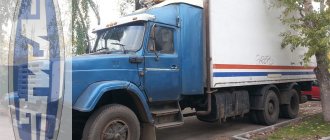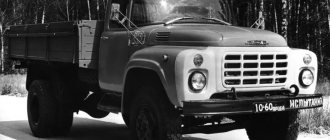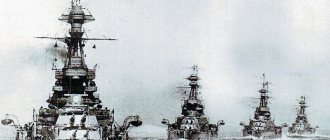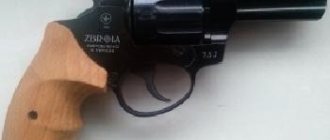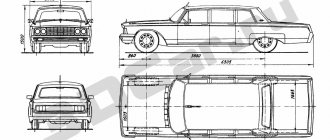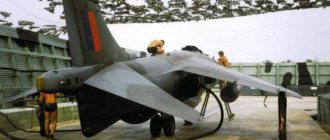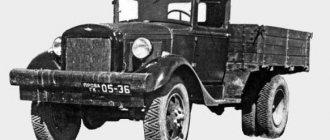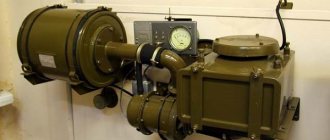ZIL-4104 is a Soviet executive car in the back of a limousine. The development and further production of this model was carried out by the Likhachev Plant from 1978 to 1983.
The car replaced the ZIL-114, which had enormous technical potential and an impressive resource. The replacement of a completely successful car is primarily due to a change in fashion in the automotive industry. If earlier the design used smooth and streamlined shapes, now strict and angular outlines have become modern.
Development of the new car began in 1974, when the first plasticine model was created. The unit from its predecessor ZIL-114, which underwent several significant modifications, was chosen as the power plant. The engine was boosted, its displacement was increased, and two upper camshafts were installed when previously one lower one was used. As a result of the modifications, it was possible to achieve a maximum output power of 315 horsepower.
For experimental versions and cars of the first production, the index ZIL-115 was assigned. However, due to the use of a new classification system in the USSR, this car was renamed ZIL-4104.
Modifications
Although the ZIL-4104 car was produced in small quantities, its base served as the basis for the creation of a very large number of modified versions. This is because some government needs were not met by the standard model. The entire list includes the following versions:
- ZIL-41041. It is a shortened modification used in accompaniment;
- ZIL-41042. It is a medical modification with a station wagon body. This version transported important passengers to the hospital. Similar versions have already been created on the basis of the ZIL-114, but in connection with the update of the base vehicle, it was necessary to update the medical ones;
- ZIL-41043. This model was equipped with a mobile radiotelephone communication system for conversations with various command facilities and other similar services;
- ZIL-41044. It is a ceremonial version, released in a phaeton body. The wheelbase of this model was shortened, and therefore the body has only two doors. The rear seat was removed and a cabinet with a grab handle was installed instead. Cars were produced in gray color;
- ZIL-41045. It is a restyled model of the regular version of ZIL-4104. The technical component remained without any changes, but the appearance was complemented by an updated radiator grille, square headlights (previously round ones were used), modified side moldings and much more. Production of the modification was carried out from 1983 to 1985;
- ZIL-41046. It is an improved version of the ZIL-41043 car. The Caucasus radiotelephone communication system is installed here;
- ZIL-41047. This is the latest update to the base car. Its production started in 1985. Starting this year, the limousine began to be equipped with modified headlights and an updated radiator grille, as well as front side windows without windows and other rear-view mirrors;
- ZIL-41072. This model was used by government security forces. Externally, this modification is practically no different from the base car, but the interior has been slightly modified. It was equipped with special handrails for convenient firing and a hatch in the roof. Production of ZIL-41072 began in 1989, and 8 copies have been produced since then.
In addition to all the above versions, the Likhachev Plant also produced several armored versions, created on the chassis of the ZIL-4104, ZIL-41045 and ZIL-41047 models.
Such modifications were essentially an armored capsule with the design of a standard car. Instead of ordinary glass, glass with increased strength was used. The standard gas tank was replaced with a special one that seals bullet holes. This is necessary to prevent fire. During the entire production period of the limousine, 14 armored versions were produced.
History of creation
By the mid-70s of the 20th century, the USSR was at the peak of its power and influence. The United States left Vietnam, Arabs and Africans seemed to be learning to fight Western imperialists. Pro-Soviet India detonated a nuclear weapon and drove Pakistan out of Bangladesh. The world was changing and fashion was changing with it, including automotive fashion. ZIL-114 and its modifications were good, but I wanted to keep up with fashion. The leaders of a great country had to drive a car worthy of their status. At the same time, an armored limousine would be created. After Stalin's death they were not released from us. But it became clear that he was needed. Since the late 60s, terrorism has reappeared in the USSR, something that had been forgotten during the lifetime of Felix Dzerzhinsky. But the design of the ZIL-114 did not allow the installation of the necessary armor.
And since 1974 The creation of a new government limousine began. Initially, they wanted to put it on the assembly line in 1977, for the 60th anniversary of the October Revolution. But they didn’t have time - production was launched in 1978. It was developed independently by Soviet specialists, minus the design - the British company Carso was involved in it.
In terms of luxury and convenience for passengers in the back rows, it has caught up with the Roll-Royse and surpassed American limousines. At the same time, as if there was no oil crisis in the world, it became the longest passenger car produced at that time. The curb weight was 3,335 tons. But thanks to the V8 gasoline engine of 315 hp. with a volume of 7,695 l3 it could reach a speed of 190 km/h. Fuel consumption – 22 l/100 km. The car had a tank with a volume of 120 liters, into which AI-95 was poured, which was then only for cars of the Special Purpose Garage (GON). And they only gave it out at government gas stations, under the name “Extra” variety.
Detonation was excluded by the design features of the engine. The powerful and heavy frame together with the suspension made it almost impossible for the car to overturn. The suspension also ensured an extremely smooth ride and no “dive” when braking.
For the first time in the Soviet Union, the brakes were not only disc, but also ventilated on all wheels. The ignition system was duplicated.
ZILs from the ZIL-4104 family are on display at the ZIL plant museum in Moscow. Modification indices can be seen on plates in place of license plates.
Initially, his appearance was kept secret. The cars had ZIL-115 nameplates. And only in 1983 was its existence recognized. At the same time, its first restyling was carried out - ZIL-41045, and in 1986. the next one is ZIL-41047. The existence of the latter was recognized only in the early 90s. But these cars differed only in appearance. The armored version (ZIL-4105) was put into production in 1983. At that time, it was the most protected of similar vehicles with hidden armor. The car was made around an armored capsule produced by the Kurgan Machine-Building Plant. This fundamentally distinguished it from most foreign analogues.
This technology was possible only in the case of small-scale production slipways, which is typical of ZIL limousines. The conveyor belt was abandoned there after Stalin's death. But it was precisely this solution that provided the highest degree of security at that time, including protection against anti-tank mines. Externally and in the design of the main components and assemblies, it did not differ from its standard counterparts.
Currently, machines of this family are practically not used for their original purpose. The last serial ZIL-41047 was made in 2002 for the President of Kazakhstan N.A. Nazarbayev.
Appearance
In the 1970s, the global automotive industry began to change the fashion of car design. Thus, the fin style popular in the 1950s was replaced by more angular and strict outlines. Such changes affected not only American and European manufacturers, but also the Soviet ZIL plant.
In 1974, a plasticine model was developed, and in 1977 the car itself was developed. The radiator grille was chosen as the central part of the appearance. This element gives the car elegance, severity, and, well, heaviness. Chrome lining appeared on the wheel arches.
Restyling of the model
Specialists of the plant named after. Likhachev, after Gorbachev took over as head of state, they decided to restyle the limousine. The need for an update was due to political reasons, not technical ones: the characteristics of the ZIL-41047 were excellent, the engine and chassis were created with a significant design margin, which made it possible not to make changes to parts and components for a long time.
The government limousine in the “era of change” began to be produced in a new version. The changes affected mainly the appearance of the car, which is noticeable from the photo ZIL-41047: the radiator received a more expressive lining, the headlights received a square design from Bosch, the turn signals were moved to the front wings, the rear optics occupied the entire space of the rear of the body, the front side windows lost their windows , side rear-view mirrors began to be installed in the corner of the window, and not on the door, as before.
Such cosmetic changes made it possible to update not only the exterior, but also the interior of the ZIL-41047. Some car systems have undergone technical improvements - for example, the eight-cylinder engine received an electronic contactless ignition system.
The hydromechanical transmission, which ZIL-41047 received from the previous model, 41045, was also modernized in 1988: the design of the freewheel and adjacent parts was changed, which increased the reliability of the design. The updated limousine was equipped with 16-inch wheels and wide tires. “Granite” tires were distinguished by a special design, thanks to which the car could move with a completely flat tire, which was achieved due to the sidewalls of increased rigidity and a special gel inside the tire.
Salon
The car has a closed all-metal body with four doors. Up to 7 people can be accommodated inside. There is a glass partition between the front and back rows. The middle seats can recline if necessary.
ZIL-4104 turned out to be really very comfortable. This was greatly influenced by sophisticated and efficient air conditioning, heating and ventilation systems. In addition, the model's interior is equipped with an all-wave stereo radio and electric windows.
The steering column has several adjustments and can also tilt upward. Thanks to this, the driver's entry is greatly facilitated.
The rear seats, made in the form of a comfortable sofa, have an electric drive that allows you to adjust the angle of the backrest and the position of each seat. The front seats use leather upholstery, while the rear row has plush or velor upholstery.
The driver's seat is equipped with many different adjustments, which allows you to customize the driver's workplace taking into account almost any factors.
The interior of the car has a lot of liners, in the manufacture of which natural walnut wood was used. However, this is not the only option, since some versions also used mahogany.
To maintain the required temperature conditions in the cabin, two climate control units were installed, one of which is responsible for the passenger compartment, and the second for the driver’s compartment. Additionally, the climate in the cabin was influenced by determal glass, consisting of three layers. They allow you to maintain the temperature of the cabin regardless of environmental conditions. It is worth noting that the first models of this car used Belgian-made glass. But later they were replaced by domestic ones.
For lighting on the ceiling, there are several separate lampshades located in the corners.
The ZIL-4104 car has excellent sound insulation. This is explained by the fact that the insulating material has a thickness of 50 millimeters. Thanks to this, there is almost silence in the cabin when moving.
The partitions located between the driver and passenger compartments are electrically driven. The controls for these drives occupy the upper plane on each armrest of the rear doors. There are also control buttons for power windows and the standard audio system.
The console, installed in the central part of the car, contains control units for the air conditioning and equipment such as a loudspeaker, an alarm system and a standard music system. There is a special communication unit between the front seats.
The dashboard includes a speedometer, tachometer and other most important indicators. The first two indicators are integrated into round wells with cone-shaped glasses that prevent glare.
Brake system
The car's brakes are disc mechanisms installed on all existing wheels. The system is equipped with a hydraulic drive. The gaps are adjusted automatically. There is also an internal cooling system consisting of two circuits, each of which directly affects all wheels. In addition, each circuit is equipped with a vacuum booster. Such a unit is located on the master cylinder of the parking brake - this is already a drum mechanism on the rear wheels. It is activated by pressing the pedal. When the vehicle starts to move, the parking brake stops working.
Specifications
Engine
For the ZIL-4104, an eight-cylinder gasoline power plant with a V-shaped cylinder arrangement was chosen. This engine has 16 valves in the gas distribution mechanism. With a rather impressive working volume of 7.7 liters, it develops a maximum output power of no less serious 315 horsepower. The maximum torque is 608 Newton meters, which provides excellent traction even at low speeds.
The engine is equipped with a carburetor fuel system, including a four-chamber K-259 carburetor, developed on the basis of American copies.
In addition to excellent power characteristics, the designers also provided the car with increased reliability and reliability. For this purpose, duplicate nodes were added. Thus, ZIL-4104 has a duplicated electrical circuit of the ignition system, two fuel pumps and two batteries.
Fuel consumption
The average fuel consumption of a ZIL-4104 vehicle varies from 20 to 30 liters of fuel per 100 kilometers. Moreover, it was recommended to use AI-95 gasoline, which in Soviet times was not available for free sale and was called “Extra”.
Historical reference
The ZIL 4104 car was produced for five years. Its creation and production from the factory assembly line was carried out by the plant named after. Likhacheva. The developers assigned the index 115 to the car. However, after some time, due to a change in the classification system in the Union, the elite “iron horse” received the number 4104. All existing modifications of the car based on this titanium were produced until 2002.
checkpoint
The transmission for this car was an automatic three-speed planetary-type gearbox with hydraulic control. Since the drive wheels of the ZIL-4104 were rear, torque was transmitted from the engine via a cardan shaft with an intermediate support.
Despite the fact that the installed gearbox has only three gears, the third one was made as long as possible, which made it possible to move at high speed without feeling discomfort.
Automatic gearbox
This vehicle unit is equipped with hydraulic transformers and has three gears. To change the stage, use a selector switch, which is located between the front seats. The design of the box provides for a mechanical stopper, which in turn allows you to reliably hold the car on a descent. It is deactivated automatically the moment you start moving. An intermediate support separates the two cardan shafts. The rear axle has the form of a continuous stamped-welded beam. The final drive ratio is 3.62. The wheel hubs are mounted on tapered roller bearings.
Chassis
At the front, the car is equipped with an independent suspension with wishbones and double-acting telescopic hydraulic shock absorbers. At the rear, a dependent suspension design with springs, traditional for cars of that time, was used.
An interesting feature is that the tires used are puncture resistant. As tests have shown, they are able to withstand up to 7 punctures and the tires do not sag and can withstand the weight of the vehicle. This is explained by the fact that special tires with a rigid sidewall were made for the limousine. For additional protection against depressurization, a special gel was used instead of air.
dimensions
- Total length – 6339 mm;
- Full width – 2086 mm;
- Total height – 1500 mm;
- Wheelbase length – 3880 mm;
- Ground clearance – 170 mm;
- Front track width – 1643 mm;
- Rear track width – 1663 mm;
Electrical equipment
All electrical components of the vehicle are powered by a 12-volt system. It operates thanks to a generator generating power of 1.15 kW and a pair of batteries with a capacity of 120 Ah each. To ensure optimal illumination of the roadway at night or in bad weather, the fog and headlights are equipped with halogen lamps.
Peculiarities
An interesting feature is that the car carrying L.I. Brezhnev, had red velor and gilded handles in the interior. Since such a solution was practically impossible to implement in the USSR due to the lack of necessary technologies, the body of the limousine was sent to England, where the interior was redesigned.
However, for all other important passengers, the ZIL-4104 and its modifications were of the same type as the standard cabin. This is explained by the fact that, if necessary, the car could easily be replaced, and the passenger would not even notice it.
The ceremonial version of the car was painted only in gray, reminiscent in shade of a general's overcoat. At the same time, the upholstery was also changed, which became yellow-red leather.
In addition to these models, there are also armored ones, of which 14 were produced over the entire period. In such modifications there was indeed a very high level of safety, for all passengers and the driver. In some places of the body there is armor 80 millimeters thick, and all the glass is 85 millimeters thick, which is quite impressive. As tests have shown, all this is capable of withstanding even 7.62 caliber bullets with a hardened core.
The roof of the car and the bottom were reinforced, which made it possible to withstand grenade explosions. The fuel tank is also well protected.
The limousine was equipped with special tires that have increased puncture resistance. This is due to the durable sidewall. Thanks to this, it was possible to quickly evacuate important passengers from a dangerous place. Another interesting feature is that the design of the car has impressive stability, making it almost impossible to turn it over.
For ease of control, the ZIL-4104 was equipped with a hydraulic power steering mechanism. In addition, the steering column has several adjustments, which allows you to adjust the workplace taking into account many of the driver’s preferences. The salon was really very luxurious for that time. There are natural wood inserts and pleasant upholstery, usually velor or plush. All seats have a comfortable shape and are equipped with many settings. The free space in the cabin is huge, especially on the second row of seats. Wide doors were installed for more comfortable entry. The luggage compartment also has a fairly large usable volume.
For this car, a powerful V-shaped eight-cylinder power unit with a carburetor power system was chosen. With a working volume of 7.7 liters, it develops a maximum output power of 315 horsepower, which endowed such a large and very heavy car (total weight is 3860 kilograms) with quite good dynamics.
The chassis of the base limousine served as the basis for the creation of a large number of different modified versions used in motorcades and some special missions. Such modifications are currently either in museums or in the garages of private collectors.
The ZIL-4104 was in service until the collapse of the USSR. Despite the fact that the car was very comfortable, safe and met all the requirements of the executive class, the new officials preferred foreign Mercedes-Benz models instead.
In this regard, this model has almost completely lost demand. Only a few were produced and only for private individuals. In 2010, the almost empty plant received an order to assemble new ceremonial government convertibles. They were assembled from the remaining parts.
In 2013, the Likhachev Plant finally stopped producing cars. Currently, the plant is completely destroyed, but things turned out better for the workshop that assembles limousines. Now this workshop is a separate company under the name MSC-6 AMO ZIL LLC, where assembly and repair work on old limousines is still carried out.
Hackwork and Christmas trees
As already mentioned, we were not spoiled with a salary, which is why everyone was looking for an opportunity to earn extra money. The most common is to organize a transfer to the client for cash during the resource roll-out. This is a test mode in which it is required that the experimental unit installed on the car complete the mileage specified by the engineers. The test driver passes a certain mileage daily (about 450 km), and the driving route, although agreed upon, remains quite free.
The second option is wedding services. To do this, it was necessary to submit an application in advance for permission to use the car for personal purposes on a day off, and pay 254,000 rubles to the cashier. (after the 1998 denomination it cost 254 rubles) and receive a waybill “to all four directions.” Such happiness (the standard tariff for “ZIL limousines” for weddings on the eve of default is 200,000 non-denominated rubles / hour) did not happen to me often, since I was the youngest driver and a certain “hazing” was applied to me, however in the most harmless form what this phenomenon could be. The fact is that such a permit could only be obtained for the light ZIL-41047, the heavy 41051 and 41052 were secret products and were not released “in person”. And I was assigned a well-worn ZIL-41051, produced in 1985, since the newer and lighter 41047 was taken over by old-time colleagues, and I could only drive a light car as a substitute during their vacation or sick leave.
The thickness of the windshield and rear glass of the “51” is 43 mm, the side windows are even thicker - 47 mm, as a result, in the area of the A-pillars you see completely different distances to other cars, poles and pedestrians, add to this tiny mirrors, in a word, concentration Enormous attention is required. By the end of the day, especially a winter one, with early twilight, you clearly feel a headache. This heavyweight also requires special tires. They were not issued for everyday simple work because of the high cost and I had to make do with whatever I got, which is why I once spent several hours on the side of the Simferopol highway: an exploding tire damaged the brake hose. But I went to my own wedding in a motorcade of two ZIL-41047s. But when the time came to go pick up the bride, the carburetor of one of the cars malfunctioned, the over-enriched mixture flooded the spark plugs and the engine did not start. The groom had to roll up his sleeves without taking off his wedding suit (there was no time!) and urgently organize the purging of the cylinders; even this photographic fact was preserved in the family archive (my father took a photograph of me).
Four months later, December arrived with the New Year's bustle. We carried out a series of resource tests on highways. On our way, on the outskirts of the Moscow region, near the border with the Tula region, there was a nursery from the local forestry, where you could very inexpensively choose and cut down a Christmas tree yourself. Having learned about this, several of our colleagues wished us to leave an order for the New Year's beauty, and my partner and I (we did long winter runs every day, so we worked together) arrived at the forestry office. After a short paperwork, the forester looked at us and said that we were city people, and so as not to mess up his farm, he would give us a couple of his workers to help us.
And now our company, consisting of your humble servant - the driver, another driver and two men from the forestry department, is about to go to the plot. The conversation goes something like this: “What kind of car do you guys have? ZIL... That’s great, we’re just on the “131st” from there (meaning ZIL-131 6x6 army truck. - Author), in principle, we can drive..." “And here’s ZIL, our ZIL-41051 , he’s like 115, well, let’s go?” The silent scene lasts no longer, but not less than a minute, men in quilted jackets and felt boots with axes are located on the back sofa in the passenger compartment, which in half an hour will be filled with the New Year's aroma of fresh pine needles.
Then there was summer, a series of tests on mountain serpentines in the Krasnodar region: Goytkhsky Pass, Goryachiy Klyuch, Krasny Kamen. And the urgent transportation of fresh fruits, watermelons, melons in one sitting to Moscow in order to please loved ones - full air conditioning, then, as payback for the forced technical cold, a fierce cold, fever, runny nose, cough... But life is still in full swing, in a good way this word. This is forever in my memory and can never be repeated. Thank you, ZIL! For all!
Price
Currently, the cost of the Soviet limousine ZIL-41047 starts at 10 million rubles. In the basic configuration, the model is equipped with a 7.7 liter V-shaped eight-cylinder engine with a maximum power of 315 horsepower, hydraulic power steering, separate climate system, air conditioning, velor interior, and electric windows.
It should also be noted that the car is quite rare, at least on the secondary market.
ZIL-4104 in service
During the use of ZIL-4104 limousines in the Special Purpose Garage, this car carried many high-ranking officials, and first of all these were the general secretaries of the CPSU Central Committee. The first general secretary to move to the new ZIL was Leonid Ilyich Brezhnev - from 1978 until the end of his tenure, he traveled on the ZIL-4104 model.
Following Brezhnev, Yu.V. Andropov and K.U. Chernenko drove an updated version of the ZIL limousine, bearing the index 41045. For Mikhail Gorbachev, who came to power in 1985, they released a new modification of the ZIL-41047, which he drove until leaving office head of state.
The first President of Russia, Boris Yeltsin, initially also used a domestic limousine, it was an armored ZIL-41052, but later he replaced it with an armored Mercedes-Benz Pullman limousine produced on special order based on the W140 generation sedan.
In addition to general secretaries, ZIL-4104 limousines also transported various important officials, party workers, and ministers.
They were also used by security guards accompanying important people. ZiLs were also actively used in parades.
Content
- 1. History
- 2 Technical characteristics 2.1 Body
- 2.2 Engine
- 2.3 Transmission
- 2.4 Chassis
- 3.1 ZIL-41041 Sedan
Notes[ | ]
- Domestic passenger cars, 2009.
- Vladimir Vinnik.
Practice of party limousine production (ZIL-115) (Russian). RETRO CAR MUSEUM (July 22, 2009). Access date: October 22, 2012. Archived November 5, 2012. - ZIL-41041 sedan (Russian). JSC “Plant named after I.A. Likhachev." Access date: October 22, 2012. Archived November 5, 2012.
- ZIL 41041 (1986 – 2000) (Russian). Retro cars (November 26th, 2009). Access date: October 22, 2012. Archived November 5, 2012.
- Autoreview No. 20, 2012.
- The main car of the Victory Parade
- Military, but peaceful: all ceremonial cars of the USSR and Russia
- Secrets of the development of “Putin’s” Aurus limousine: which cars will be shown at the parade
- Convertibles, which have opened parades in Moscow for the last 9 years, were brought to St. Petersburg
- ↑ 12
Billions - for the Cortege Archived copy from July 12, 2014 on the Wayback Machine - ↑ 12
The Last Parade Archived February 28, 2014 on the Wayback Machine - ZIL-41047, 2010, p. 15.
- Alexey Khresin.
Black Doctor (Russian) (inaccessible link). MOTOR/MOTOR (April 1997). Access date: October 22, 2012. Archived January 8, 2014. - ZIL-41072 “Scorpion” (Russian). Retro cars. Access date: October 22, 2012. Archived November 5, 2012.
New solutions in body design
The ZIL-4102 car with a sedan body fully corresponded to the wishes of the Secretary General. But the time frame for building the first sample was very tight - no more than 6 months were allotted for all work. Due to tight deadlines, development of design and construction solutions was carried out on a full-size sedan mock-up.
As a result, the design team led by E.D. Gusev managed to create a car with solutions that were completely uncharacteristic of ZIL products. To facilitate the design, the body of the ZIL-4102 was made according to a load-bearing design. Composite materials were used in the design of a number of body parts, which increased body rigidity and further reduced weight. As a result, the curb weight of the vehicle was 3.25 tons. Considering the overall dimensions of the machine, the weight indicator is very good.
Additional strength was given to the body by the windshield and rear windows glued into the openings. Adhesive joints were used to connect some body parts. Description of ZIL-4102 will not be complete without mentioning the high quality of sound insulation of the body. The engine and transmission were covered with a special casing, which reduced noise and prevented dust from entering components and assemblies. External body panels, prone to vibration, were covered with soundproofing materials and equipped with structural reinforcements.
GAZ-13 – the progenitor of the “Chaika” family
GAZ-13 is the progenitor of the Chaika family.
Photo source: Superiormale Undoubtedly the most famous Soviet government car was the “Chaika” - a series of cars whose history should be counted from the appearance of the GAZ-13 car in 1959. It is believed that of the three thousand first-generation Seagulls produced, only three fell into private hands (the owners of such cars were the writer Mikhail Sholokhov, the first Soviet female cosmonaut Valentina Tereshkova and ballerina Galina Ulanova), the rest were used for government needs in the USSR and abroad . For example, the leaders of the GDR, Walter Ulbricht and Eric Honecker, drove the GAZ-13. Several cars were given to Intourist.
Executive sedan
In 1985, a new limousine ZIL-41047 appeared in the plant’s production program. The appearance of the new car practically coincided with the change in the country's leadership - M. Gorbachev became the head of the USSR. The car was based on the components of its predecessor, model 41045, and was distinguished by front end trim elements, lighting equipment and the absence of windows in the front doors. The country's new leadership received the new model positively and used the limousine for some time.
But towards the end of 1986, M. Gorbachev had a desire to get a less bulky executive car. A year later, this desire took shape in a technical specification and was sent to ZIL. The customer of the car was the Kremlin GON. By this time, the designers of the ZIL passenger division had been working for several years on the project of a new limousine, which was completely different from the cars being produced.
The project acquired its final features and included two versions of the car - a seven-seat limousine ZIL-4101 with an extended base and a short five-seat sedan ZIL-4102. Theoretically, car bodies could have a hard or soft top.
Soviet limousine
Being an unattainable dream for Soviet car enthusiasts, ZIL-114 was created to serve foreign embassies and the leadership of higher government institutions.
Comfortable movement was ensured by a fully hydraulic suspension, which did not allow potholes on the roads to disturb the important passenger. The basis of passenger safety was considered to be the X-shaped design of the car frame, which has side members with a volumetric cross-section
This architecture provided greater resistance to possible deformations and damage.
The design of the car body had strict straight shapes, harmoniously combining the enormous length of the limousine and low height dimensions. It was when designing the ZIL-114 car that Soviet engineers moved away from directly copying American cars and began developing their own design and technical solutions, which made it possible to create unique elite vehicles.
